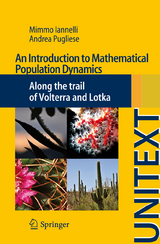An Introduction to Mathematical Population Dynamics
Springer International Publishing (Verlag)
9783319030258 (ISBN)
This book is an introduction to mathematical biology for students with no experience in biology, but who have some mathematical background. The work is focused on population dynamics and ecology, following a tradition that goes back to Lotka and Volterra, and includes a part devoted to the spread of infectious diseases, a field where mathematical modeling is extremely popular. These themes are used as the area where to understand different types of mathematical modeling and the possible meaning of qualitative agreement of modeling with data. The book also includes a collections of problems designed to approach more advanced questions. This material has been used in the courses at the University of Trento, directed at students in their fourth year of studies in Mathematics. It can also be used as a reference as it provides up-to-date developments in several areas.
Prof. Mimmo Iannelli, Dipartimento di Matematica, Facoltà di Scienze, Università di Trento, Italy. Prof. Andrea Pugliese, Dipartimento di Matematica, Facoltà di Scienze, Università di Trento, Italy.
1 Malthus, Verhulst and all that.- 2 Delayed population models.- 3 Models of discrete-time population growth.- 4 Stochastic modeling of population growth.- 5 Spatial spread of a population.- 6 Prey-predator models.- 7 Competition among species.- 8 Mathematical modeling of epidemics.- 9 Models with several species and trophic levels.- 10 Appendices: A Basic theory of Ordinary Differential Equations; B Delay Equations; C Discrete dynamics; D Continuous-time Markov chains.
"The book introduces the reader into several ways of mathematical modelling, and also gives explanations on the relation between the different aspects. The structure of the book is very logical and it is easy to read and understand. ... A rich collection of problems ... can be found at the end of each chapter, which help to introduce students into the process of modelling through own experience. ... it also provides up-to-date results in several of the topics included." (Attila Dénes, Acta Scientiarum Mathematicarum, Vol. 81 (3-4), 2015)
"The book under review is based on an introductory course on the mathematical modeling of biological phenomena. This is a textbook for students of mathematical sciences to accompany an advanced undergraduate course in the modeling of population dynamics using ordinary differential, delay differential, stochastic and difference equations. ... It is a good introduction for those beginners that are interested in the fast growing field of mathematical biology." (Leonid Berezanski, zbMATH, Vol. 1305, 2015)
| Erscheint lt. Verlag | 23.7.2014 |
|---|---|
| Reihe/Serie | La Matematica per il 3+2 | UNITEXT |
| Zusatzinfo | XIV, 346 p. |
| Verlagsort | Cham |
| Sprache | englisch |
| Maße | 155 x 235 mm |
| Gewicht | 614 g |
| Themenwelt | Informatik ► Weitere Themen ► Bioinformatik |
| Mathematik / Informatik ► Mathematik ► Angewandte Mathematik | |
| Naturwissenschaften ► Biologie ► Ökologie / Naturschutz | |
| Schlagworte | Applied dynamical systems • Biomathematik • Ecological modeling • Mathematical Biology • Mathematical epidemiology • Molecular Networks |
| ISBN-13 | 9783319030258 / 9783319030258 |
| Zustand | Neuware |
| Informationen gemäß Produktsicherheitsverordnung (GPSR) | |
| Haben Sie eine Frage zum Produkt? |
aus dem Bereich




